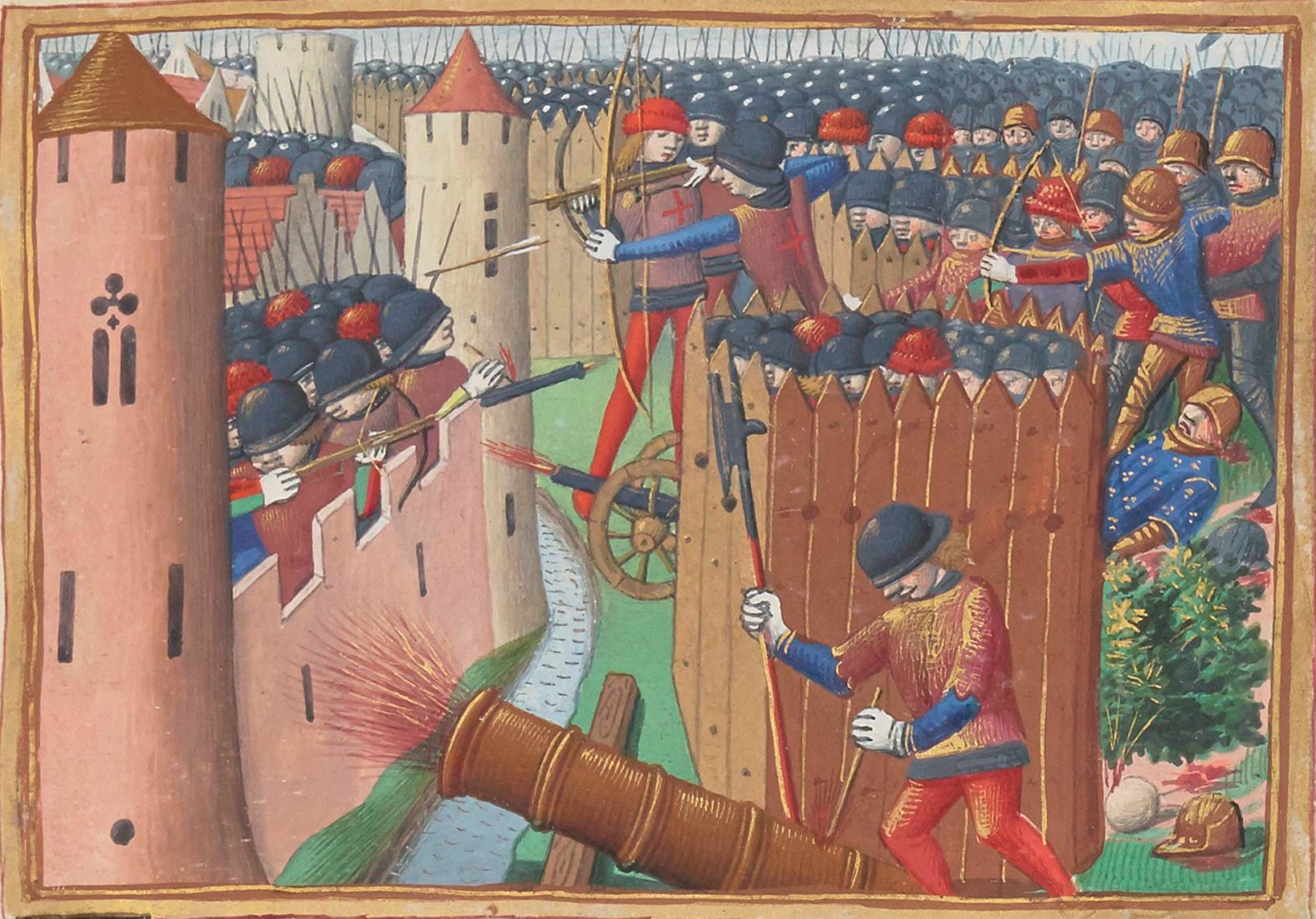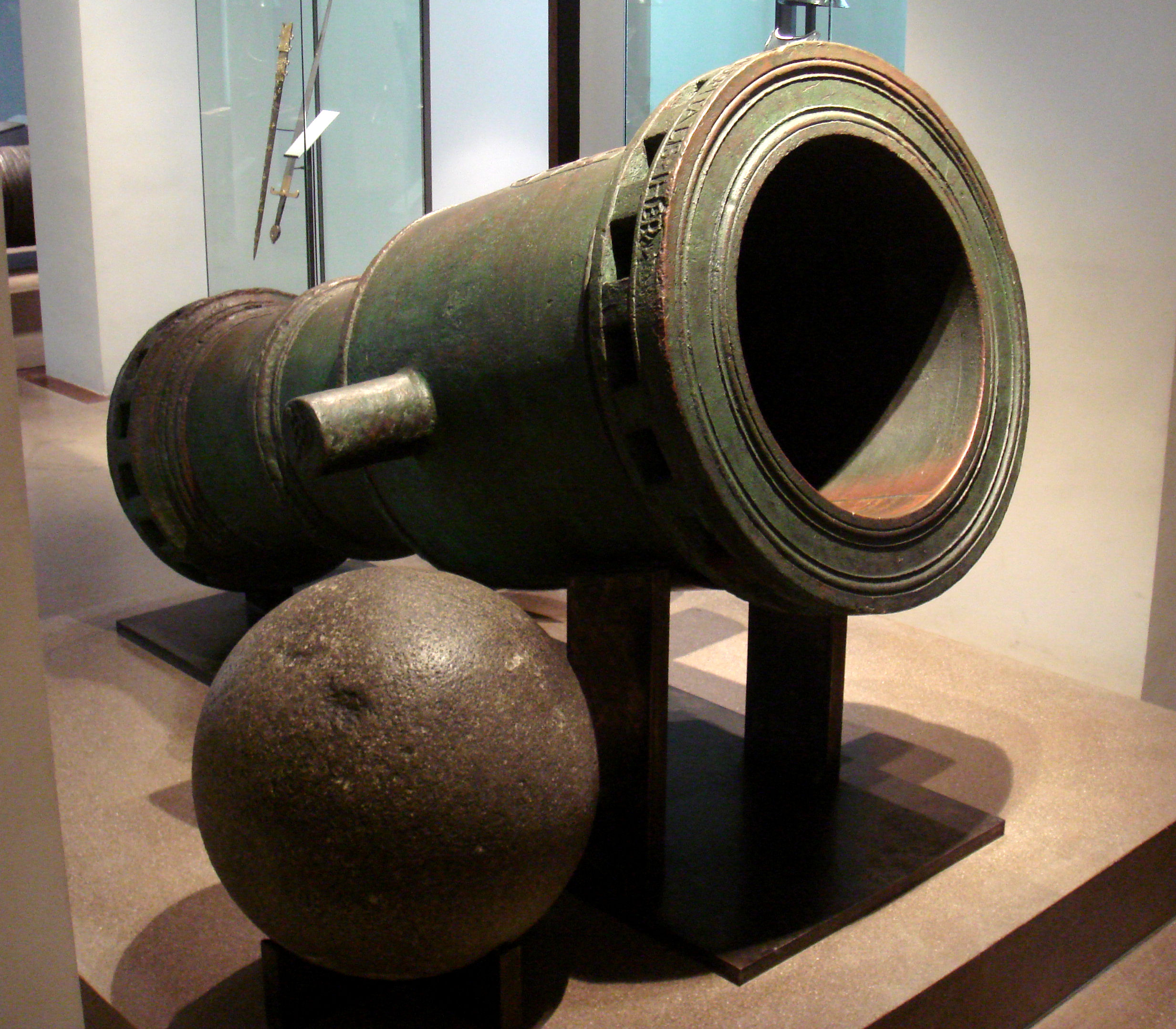|
Veuglaire
The Veuglaire (derived from the German ''Vogler'' and ''Vogelfänger'', and the Flemish ''Vogheler'', after a gun manufacturer named Vögler. English: Fowler) was a wrought iron cannon, and part of the artillery of France in the Middle Ages. There, guns were initially called , or . The ''Veuglaire'' was up to 2 meters (8 feet) long, and weighing from 150 kg to several tonnes, and compares to the '' Crapaudins'' or ''Crapaudaux'', which were shorter (4 to 8 feet) and lighter than the ''Veuglaires''. The ''Veuglaires'' were usually breech-loading, and therefore used a separate "powder chamber" (''boîte à poudre'') in which powder and ball were located upon loading, and the main body of the cannon was formed of a tube opened at both ends. ''Veuglaires'', together with ''Crapaudins'', were considered medium-sized weapons and tended to have smaller chambers than bombards. They belonged to a category of weapons developed from the late 14th century, which had smaller bore and f ... [...More Info...] [...Related Items...] OR: [Wikipedia] [Google] [Baidu] |
Veuglaire Powder Box Caliber 130 Length 107 Early 15th Century La Fere
The Veuglaire (derived from the German ''Vogler'' and ''Vogelfänger'', and the Flemish ''Vogheler'', after a gun manufacturer named Vögler. English: Fowler) was a wrought iron cannon, and part of the artillery of France in the Middle Ages. There, guns were initially called , or . The ''Veuglaire'' was up to 2 meters (8 feet) long, and weighing from 150 kg to several tonnes, and compares to the '' Crapaudins'' or ''Crapaudaux'', which were shorter (4 to 8 feet) and lighter than the ''Veuglaires''. The ''Veuglaires'' were usually breech-loading, and therefore used a separate "powder chamber" (''boîte à poudre'') in which powder and ball were located upon loading, and the main body of the cannon was formed of a tube opened at both ends. ''Veuglaires'', together with ''Crapaudins'', were considered medium-sized weapons and tended to have smaller chambers than bombards. They belonged to a category of weapons developed from the late 14th century, which had smaller bore and f ... [...More Info...] [...Related Items...] OR: [Wikipedia] [Google] [Baidu] |
Artillery Of France In The Middle Ages
Artillery began to be used in France in the 14th century. The first depiction of a cannon in Europe appeared in Walter de Milemete's 1326 ''De nobilitatibus, sapientiis, et prudentiis regum''. Small rudimentary weapons such as the pot-de-fer or the portable bâton à feu were introduced. At this early stage, cannon would fire either stone balls or metal pellets.John A. Wagner, ''Encyclopedia of the Hundred Years War'p.34/ref> 14th-century developments The 14th century saw considerable development of the new weapons in France and in Western Europe in general, especially with the outbreak of the Hundred Years' War (1337–1453). Cannons were soon used at sea, with ships being used as a firing platform. Small guns projecting quarrels or lead pellets were used at the 1340 Battle of Sluys, and in the French defence of Tournai in August 1340. Edward III used similar weapons at the Battle of Crécy in 1346, and in the Siege of Calais in 1347. "Ribaldis" were first mentioned in th ... [...More Info...] [...Related Items...] OR: [Wikipedia] [Google] [Baidu] |
Artillery Of France In The Middle Ages
Artillery began to be used in France in the 14th century. The first depiction of a cannon in Europe appeared in Walter de Milemete's 1326 ''De nobilitatibus, sapientiis, et prudentiis regum''. Small rudimentary weapons such as the pot-de-fer or the portable bâton à feu were introduced. At this early stage, cannon would fire either stone balls or metal pellets.John A. Wagner, ''Encyclopedia of the Hundred Years War'p.34/ref> 14th-century developments The 14th century saw considerable development of the new weapons in France and in Western Europe in general, especially with the outbreak of the Hundred Years' War (1337–1453). Cannons were soon used at sea, with ships being used as a firing platform. Small guns projecting quarrels or lead pellets were used at the 1340 Battle of Sluys, and in the French defence of Tournai in August 1340. Edward III used similar weapons at the Battle of Crécy in 1346, and in the Siege of Calais in 1347. "Ribaldis" were first mentioned in th ... [...More Info...] [...Related Items...] OR: [Wikipedia] [Google] [Baidu] |
Canon
Canon or Canons may refer to: Arts and entertainment * Canon (fiction), the conceptual material accepted as official in a fictional universe by its fan base * Literary canon, an accepted body of works considered as high culture ** Western canon, the body of high culture literature, music, philosophy, and works of art that is highly valued in the West * Canon of proportions, a formally codified set of criteria deemed mandatory for a particular artistic style of figurative art * Canon (music), a type of composition * Canon (hymnography), a type of hymn used in Eastern Orthodox Christianity. * ''Canon'' (album), a 2007 album by Ani DiFranco * ''Canon'' (film), a 1964 Canadian animated short * ''Canon'' (game), an online browser-based strategy war game * ''Canon'' (manga), by Nikki * Canonical plays of William Shakespeare * ''The Canon'' (Natalie Angier book), a 2007 science book by Natalie Angier * ''The Canon'' (podcast), concerning film Brands and enterprises * Canon ... [...More Info...] [...Related Items...] OR: [Wikipedia] [Google] [Baidu] |
Wrought Iron
Wrought iron is an iron alloy with a very low carbon content (less than 0.08%) in contrast to that of cast iron (2.1% to 4%). It is a semi-fused mass of iron with fibrous slag Inclusion (mineral), inclusions (up to 2% by weight), which give it a wood-like "grain" that is visible when it is etched, rusted, or bent to structural failure, failure. Wrought iron is tough, malleable, ductile, corrosion resistant, and easily forge welding, forge welded, but is more difficult to welding, weld electrically. Before the development of effective methods of steelmaking and the availability of large quantities of steel, wrought iron was the most common form of malleable iron. It was given the name ''wrought'' because it was hammered, rolled, or otherwise worked while hot enough to expel molten slag. The modern functional equivalent of wrought iron is Carbon steel#Mild or low-carbon steel, mild steel, also called low-carbon steel. Neither wrought iron nor mild steel contain enough carbon to be ... [...More Info...] [...Related Items...] OR: [Wikipedia] [Google] [Baidu] |
Cannon
A cannon is a large- caliber gun classified as a type of artillery, which usually launches a projectile using explosive chemical propellant. Gunpowder ("black powder") was the primary propellant before the invention of smokeless powder during the late 19th century. Cannons vary in gauge, effective range, mobility, rate of fire, angle of fire and firepower; different forms of cannon combine and balance these attributes in varying degrees, depending on their intended use on the battlefield. A cannon is a type of heavy artillery weapon. The word ''cannon'' is derived from several languages, in which the original definition can usually be translated as ''tube'', ''cane'', or ''reed''. In the modern era, the term ''cannon'' has fallen into decline, replaced by ''guns'' or ''artillery'', if not a more specific term such as howitzer or mortar, except for high-caliber automatic weapons firing bigger rounds than machine guns, called autocannons. The earliest known depict ... [...More Info...] [...Related Items...] OR: [Wikipedia] [Google] [Baidu] |
Breech-loading
A breechloader is a firearm in which the user loads the ammunition (cartridge or shell) via the rear (breech) end of its barrel, as opposed to a muzzleloader, which loads ammunition via the front ( muzzle). Modern firearms are generally breech-loading – except for replicas of vintage weapons. Early firearms before the mid-19th century were almost entirely muzzle-loading. Mortars and the Russian GP-25 grenade launcher are the only muzzleloaders remaining in frequent modern usage. However, referring to a weapon specifically as breech loading is mostly limited to single-shot or otherwise non-repeating firearms, such as double-barreled shotguns. Breech-loading provides the advantage of reduced reloading time, because it is far quicker to load the projectile and propellant into the chamber of a gun/cannon than to reach all the way over to the front end to load ammunition and then push them back down a long tube – especially when the projectile fits tightly and the tub ... [...More Info...] [...Related Items...] OR: [Wikipedia] [Google] [Baidu] |
Bombard (weapon)
The bombard is a type of cannon or mortar which was used throughout the Middle Ages and the early modern period. Bombards were mainly large calibre, muzzle-loading artillery pieces used during sieges to shoot round stone projectiles at the walls of enemy fortifications, enabling troops to break in. Most bombards were made of iron and used gunpowder to launch the projectiles. There are many examples of bombards, including Mons Meg, the Dardanelles Gun, and the handheld bombard. The weapon provided the name to the Royal Artillery rank of bombardier and the word bombardment. Terminology The term "bombard" was first used to describe guns of any kind from the early to mid-14th century, but it was later applied primarily to large cannons during the 14th to 15th centuries. Despite its strong association with large cannons, there is no standard size for bombards, and the term has been applied to cannons only a meter in length as well as cannons several meters long weighing up to 20 to ... [...More Info...] [...Related Items...] OR: [Wikipedia] [Google] [Baidu] |
Culverin
A culverin was initially an ancestor of the hand-held arquebus, but later was used to describe a type of medieval and Renaissance cannon. The term is derived from the French "''couleuvrine''" (from ''couleuvre'' "grass snake", following the Latin ''colubrinus'' "of the nature of a snake".) From its origin as a hand-held weapon it was adapted for use as artillery by the French in the 15th century, and for naval use by the English in the 16th century. The culverin as an artillery piece had a long smoothbore barrel with a relatively long range and flat trajectory, using solid round shot projectiles with high muzzle velocity. Hand culverins The hand culverin consisted of a simple smoothbore metal tube, closed at one end except for a small touch hole designed to allow ignition of the gunpowder. The tube was attached to a wood or metal extension which could be held under the arm. It was loaded with gunpowder and lead bullets and fired by inserting a burning slow match into the ... [...More Info...] [...Related Items...] OR: [Wikipedia] [Google] [Baidu] |






